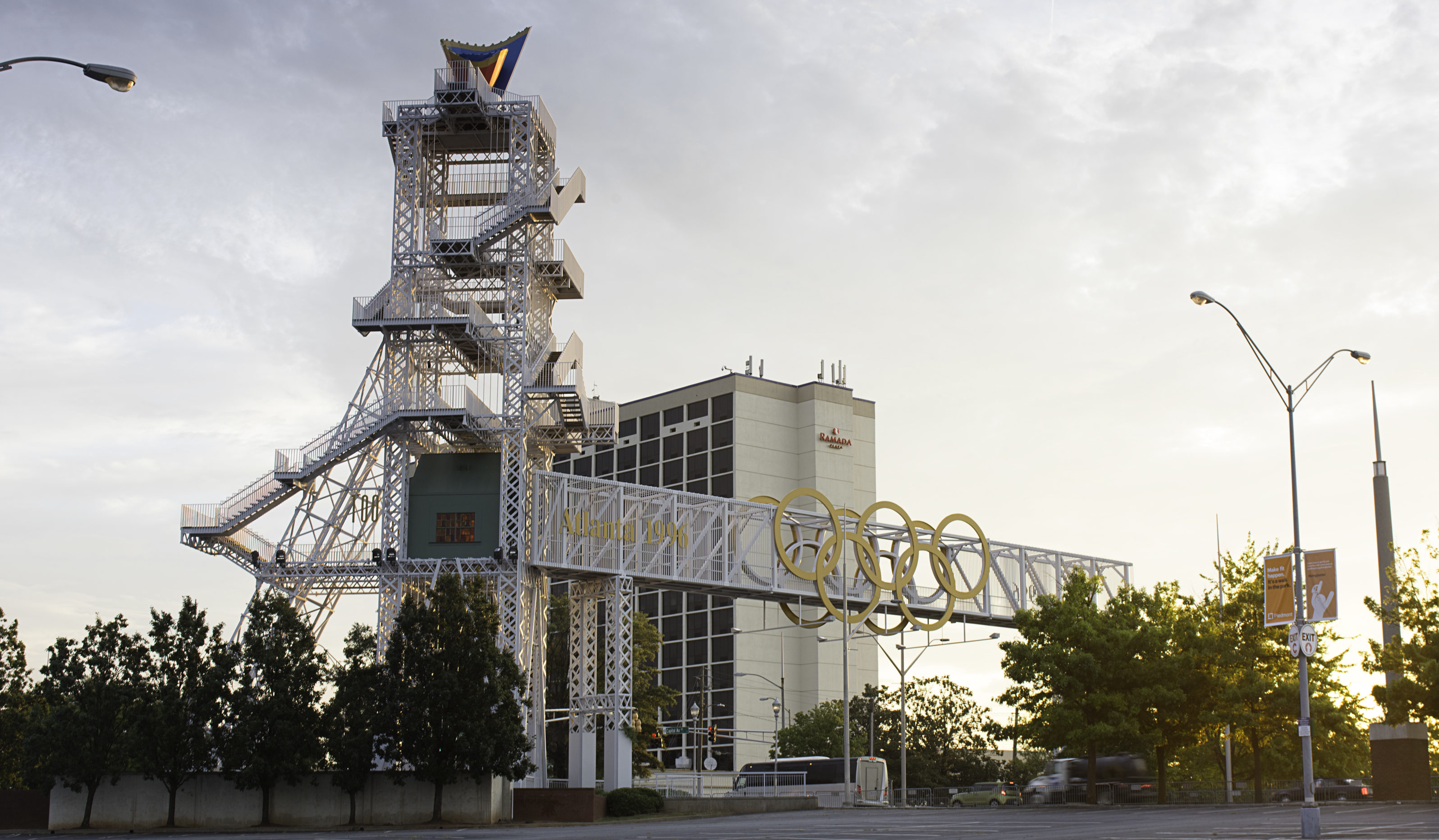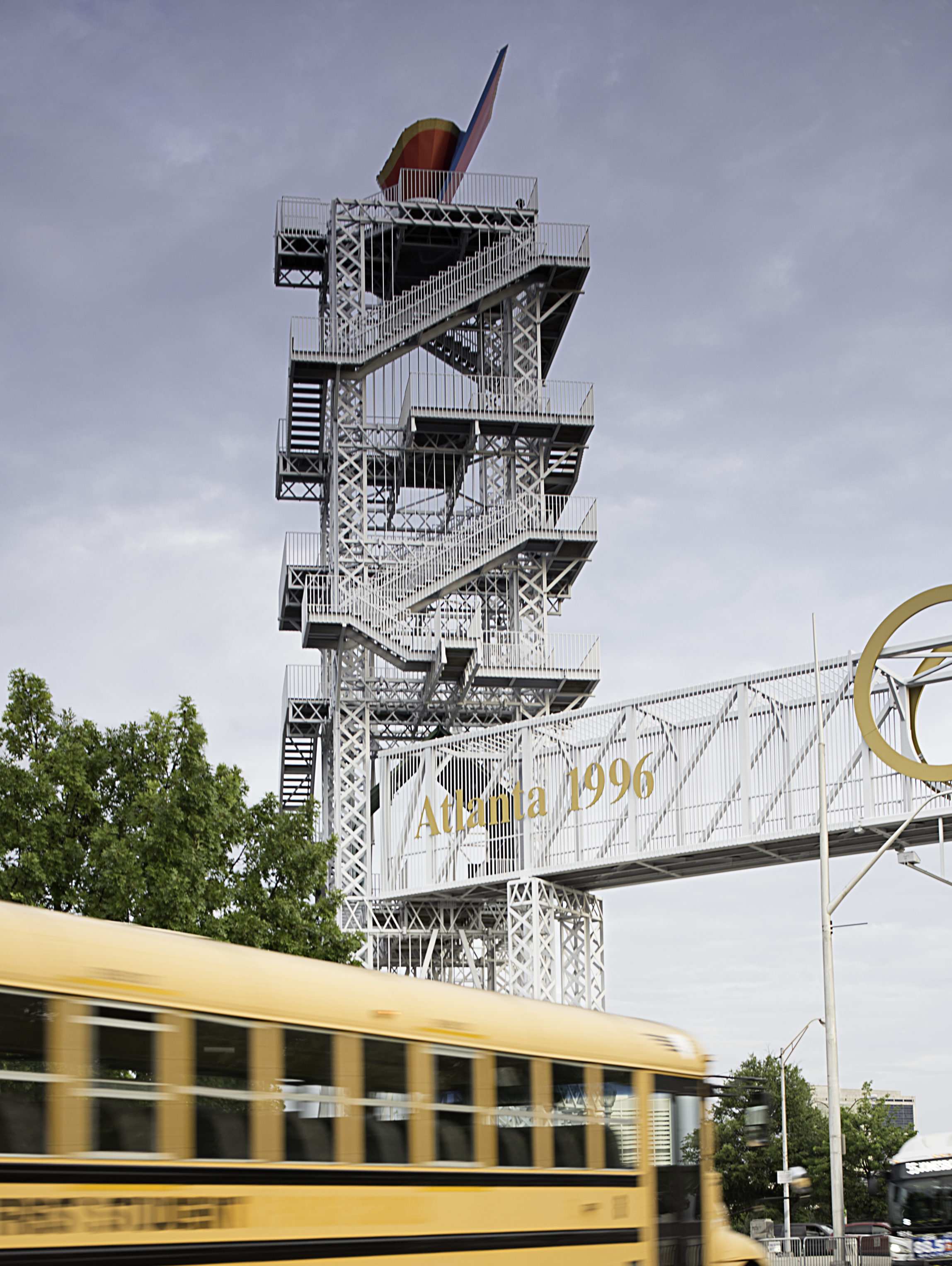
All images: Johnathon Kelso
13 Ways of Looking at an Olympic Cauldron
Share:
1. From the backseat of a car while cruising north on Interstate 75/85, as freeway-scale kitsch. It’s been lined up with a giant rotating Coke bottle and a 40-foot-tall steel cow advertising Chick-fil-A—one can see why the Atlanta Public Arts Legacy Foundation likens it to a McDonald’s French fry package.
2. From the ground looking up, beneath a mass of white scaffolding. Siah Armajani’s bridge, intended to be our Eiffel Tower, feels like an oversized fire escape. Its folded stairway does not touch the ground. A formidable hedge of holly bushes discourages climbers.
3. As a relic of the Games. In an awkward plaza at the foot of the tower, the faces of Andrew Young and Billy Payne, co-chairs of the Atlanta Committee for the Olympic Games, are etched in aluminum alongside a list of every single medal awarded that summer.
4. As a relic of 1996. Heavy gold letters bolted on both sides of the bridge seem like a self-conscious amendment to the design. The typeface recalls Apple’s condensed Garamond circa its “Think different” campaign.
5. As a three-dimensional logo. A flat red flame licking up and to the left, depending on where you stand to look.
6. On YouTube, in one of a hundred clips showing the climax of the 1996 Opening Ceremony. Muhammad Ali shuddering, unsmiling, exquisite in a white jumpsuit, extending a torch not to the cauldron, but to a strange wick on a wire. Twenty unbearable seconds as he holds the flame there until it catches brightly and travels up the wire, like some kind of flying baguette ablaze, all the way to the cauldron. Footage that, even now, will make you weep for reasons that are hard to isolate. From this angle, the cauldron is a scroll that ignites mechanically, like a stovetop burner. A televised close-up of the moment of ignition is perhaps the ideal way of looking at a cauldron.
7. As a descendant—not of some ancient Olympic ritual, but of a modern one. The torch relay from Greece leading to a dramatic lighting during a lavish Opening Ceremony—all broadcast live—was invented by Nazi propagandists for the 1936 Summer Games in Berlin.
As the stadium faces reincarnation as Georgia State University’s football stadium, everyone wants to know, what will happen to the cauldron?
8. As a memorial to the dead. As a place to toss a pair of Everlast gloves tied together, up and up until they snag on a low rung of the tower and dangle.
9. As a regret. Former mayor Andrew Young called it an “embarrassment,” and “the one place where we lost our nerve.” Armajani disowned the project, saying, “The Olympic Committee did not honor its original and contractual commitment to me and the use of the Cauldron and Bridge during the Ceremonies. I have no interest and no input on this subject.”
10. As public art connected to the public realm. The fact that Atlanta’s Olympic cauldron sits unnoticed and unloved is not an indicator of its artistic merit, but the result of being parked on the edge of a freeway and a complex of parking lots.
11. As a pawn in the redevelopment of Atlanta’s southside neighborhoods. Scoured of homes and businesses during the 1960s to make way for the interstate highways and Atlanta’s first major-league stadium, most of the 60-acre site is now dedicated to parking lots. The neighbors in Summerhill claim the remnants of the Olympics are their historic legacy. As the stadium faces reincarnation as Georgia State University’s football stadium, everyone wants to know, what will happen to the cauldron?
12. Literally, as a noun: a vessel for cooking over fire—a situation characterized by instability or strong emotions.
13. Through the lens of a Nikon as it catches the sunrise. When it looks momentarily fire-filled and glorious before the city wakes up.
Hannah Palmer is an Atlanta-based writer and designer interested in Southern stories and urban landscapes. Her first book, Flight Path, will be published by Hub City Press in April 2017.


